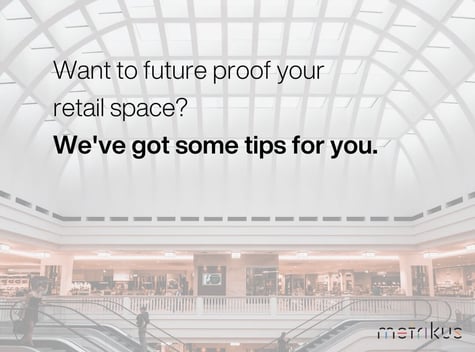How to future-proof your retail space
After stay-at-home mandates, quarantine and isolation, it’s no surprise that the COVID-19 pandemic induced a huge boom in online shopping. Ecommerce was already growing rapidly, but recent Digital Commerce 360 research found that an additional $218.53 billion has been spent online since the pandemic began.
That’s not to say physical stores have had their time. Experts predict that by 2024, 72% of retail sales across the US will take place in brick and mortar stores. So, what’s drawing people away from the ease of online shopping?
First and foremost, customers are looking for spaces that are healthy, convenient, and actually enjoyable to be in. Strap in as we explore some of the simplest ways you can create a smart shopping experience that will draw the masses away from screens and into your shop.
Smart foundations
The best place to get started is making sure you’ve got the basics right. Having a system in place to collect accurate, real-time data will give your store the foundations it needs to thrive.
But where should you start? Look no further: we’ve picked out our top three essentials.
Smart cleaning
It goes without saying that an enjoyable store needs to be clean and hygienic, as a bare minimum. There’s nothing more off putting than a space which feels uncared for, and if your customers feel like this, they’ll simply spend their money elsewhere.
Keeping retail space clean isn’t just a case of vacuuming and putting things back in the right place. It needs to be about cleaning proactively to reduce the risk of virus transmission and keep customers and employees safe.
Smart building platforms can revolutionize cleaning through showing live and historic occupancy levels which can then be used to inform smart cleaning schedules. Understanding the areas of the store that have been used the most, or perhaps not even used at all, can ensure that cleaning is more focused and effective.
Occupancy analytics can identify places which become particularly busy, such as door handles, toilets and checkouts. It may become apparent that it is necessary to clean these areas several times throughout the day in order to prevent the risk of transmission and keep everything as hygienic as possible.
Sensors can also be used to track cleaning frequencies and gain feedback in order to determine when cleaning is needed. Cleaners can then press a button to record once an area is cleaned, creating a reliable source of information that can be accessed by anyone.
Real-time inventory monitoring
Research by the National Retail Federation tells us that convenience is the top priority for a huge 40% of customers shopping in physical stores.
Is there anything worse than travelling all the way to a store only to find the item or size you need is out of stock? This is the complete opposite of convenient, and it’s a surefire way of driving your customers back online, or – even worse – to one of your competitors.
Managing your entire inventory in real time is the most efficient and accurate way to keep track of stock and sales. Depending on the software you choose, this can be fully automated, meaning time isn’t wasted on repetitive tasks that are subject to human error. Instead, your business can be reactive to changes, stay on top of supply chain needs, and monitor the location of items in stores.
On top of this, you can communicate this live data back to your customers through your digital functions so that they can check stock themselves and avoid disappointment!
Occupancy and capacity monitoring
Our next recommendation would be to incorporate occupancy and capacity monitoring into your retail space. Tracking this information in real time is the best way to understand how your space is being used, and communicate this back to your shoppers in a way that empowers them and improves their experience.
Occupancy and capacity monitoring can tell you how many people are currently in your store, as well as provide a footfall count. This information can then be used to track the usage of your space, right down to specific areas. With this data, you can work out whether your store is best configured to suit the needs of your customers; do you have adequate changing rooms? Do your checkouts correspond with the number of visitors entering your space each day?
When this information is displayed through a platform (like ours, hi!), heatmaps display the number of people in a particular area so you can see if overcrowding is an issue, while historical reporting can provide real insight into building usage trends.
If you want to go one step further, live information can be displayed to your customers through an app, website, or outside the store to inform them of how busy it is and, if needs be, advise them to come back at a quieter time.
Future-proofing against legislation
We all know that buildings account for a large portion of carbon emissions, so it’s no surprise that regulations are becoming more stringent to try and tackle their environmental impact.
If you’re not already monitoring and reporting on your energy usage, you could be caught short in light of upcoming legislation, such as New York’s Local Law 97.
- Want to learn more about how Local Law 97 could impact you and what to do about it?
Energy monitoring and reporting
Implementing a real-time energy monitoring solution can help you to reduce the carbon footprint of your retail locations, minimize energy costs, and prepare you for upcoming regulations.
Energy monitoring helps you to monitor performance and detect inefficiencies in your building systems. Recording accurate, real-time data enables you to analyze your entire building estate’s energy consumption, and it can even be overlaid with occupancy and environmental data to identify even more opportunities to reduce consumption and minimise emissions – driving major financial and environmental savings.
As energy costs continue to rise and environmental impacts become increasingly treacherous, this is something we’d definitely advise incorporating into your retail store management.
Nice-to-haves
So, you’ve got all the basics covered? Good for you!
Now you can focus on the fun stuff: have you got the budget for Clueless-style virtual wardrobes? Or maybe you want to take inspiration from Nike’s Speed Shop, a solution that centers around making the shopping experience as efficient and speedy as possible.
Check out this blog post to see what five of the smartest retail stores around the world are up to, from Lush’s app-first approach to Burberry’s adoption of social retail.




